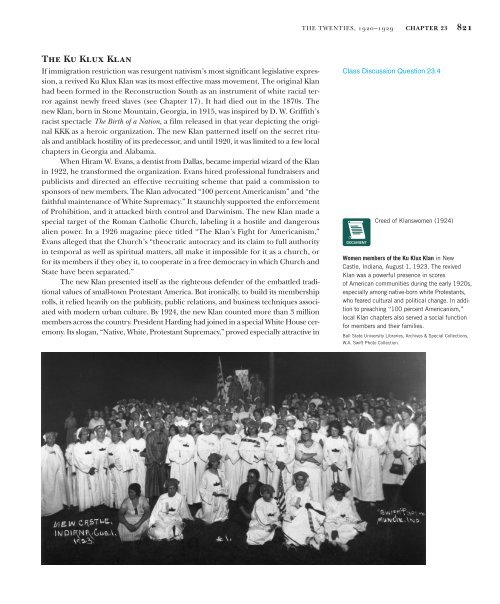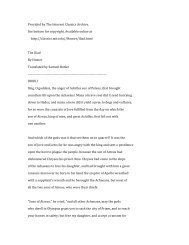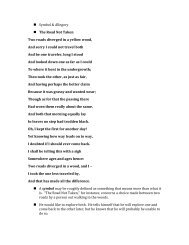71193_23_ch23_p0800-0843 4/12/10 4:21 PM Page 821THE TWENTIES, 1920–1929 CHAPTER 23 821<strong>The</strong> Ku Klux KlanIf immigration restriction was resurgent nativism’s most significant legislative expression,a revived Ku Klux Klan was its most effective mass movement. <strong>The</strong> original Klanhad been formed in the Reconstruction South as an instrument of white racial terroragainst newly freed slaves (see Chapter 17). It had died out in the 1870s. <strong>The</strong>new Klan, born in Stone Mountain, Georgia, in 1915, was inspired by D. W. Griffith’sracist spectacle <strong>The</strong> Birth of a Nation, a film released in that year depicting the originalKKK as a heroic organization. <strong>The</strong> new Klan patterned itself on the secret rituals<strong>and</strong> antiblack hostility of its predecessor, <strong>and</strong> until 1920, it was limited to a few localchapters in Georgia <strong>and</strong> Alabama.When Hiram W. Evans, a dentist from Dallas, became imperial wizard of the Klanin 1922, he transformed the organization. Evans hired professional fundraisers <strong>and</strong>publicists <strong>and</strong> directed an effective recruiting scheme that paid a commission tosponsors of new members. <strong>The</strong> Klan advocated “100 percent Americanism” <strong>and</strong> “thefaithful maintenance of White Supremacy.” It staunchly supported the enforcementof Prohibition, <strong>and</strong> it attacked birth control <strong>and</strong> Darwinism. <strong>The</strong> new Klan made aspecial target of the Roman Catholic Church, labeling it a hostile <strong>and</strong> dangerousalien power. In a 1926 magazine piece titled “<strong>The</strong> Klan’s Fight for Americanism,”Evans alleged that the Church’s “theocratic autocracy <strong>and</strong> its claim to full authorityin temporal as well as spiritual matters, all make it impossible for it as a church, orfor its members if they obey it, to cooperate in a free democracy in which Church <strong>and</strong>State have been separated.”<strong>The</strong> new Klan presented itself as the righteous defender of the embattled traditionalvalues of small-town Protestant America. But ironically, to build its membershiprolls, it relied heavily on the publicity, public relations, <strong>and</strong> business techniques associatedwith modern urban culture. By 1924, the new Klan counted more than 3 millionmembers across the country. President Harding had joined in a special White House ceremony.Its slogan, “Native, White, Protestant Supremacy,” proved especially attractive inClass Discussion Question 23.4Creed of Klanswomen (1924)Women members of the Ku Klux Klan in NewCastle, Indiana, August 1, 1923. <strong>The</strong> revivedKlan was a powerful presence in scoresof American communities during the early 1920s,especially among native-born white Protestants,who feared cultural <strong>and</strong> political change. In additionto preaching “100 percent Americanism,”local Klan chapters also served a social functionfor members <strong>and</strong> their families.Ball State University Libraries, Archives & Special Collections,W.A. Swift Photo Collection.
71193_23_ch23_p0800-0843 4/12/10 4:21 PM Page 822822 CHAPTER 23 THE TWENTIES, 1920–1929the Midwest <strong>and</strong> South, including many cities. Klansmen boycotted businesses, threatenedfamilies, <strong>and</strong> sometimes resorted to violence—public whippings, arson, <strong>and</strong>lynching—against their chosen enemies. <strong>The</strong> Klan’s targets sometimes included whiteProtestants accused of sexual promiscuity, blasphemy, or drunkenness, but most victimswere African Americans, Catholics, <strong>and</strong> Jews. Support for Prohibition enforcementprobably united Klansmen more than any single issue.On another level, the Klan was a popular social movement. Many memberswere more attracted by the Klan’s spectacular social events <strong>and</strong> its efforts to reinvigoratecommunity life than by its attacks on those considered outsiders. Perhapsa half million women joined the Women of the Ku Klux Klan, <strong>and</strong> women constitutednearly half of the Klan membership in some states. Klanswomen drew onfamily <strong>and</strong> community traditions, such as church suppers, kin reunions, <strong>and</strong> gossipcampaigns, to defend themselves <strong>and</strong> their families against what they saw ascorruption <strong>and</strong> immorality. One northern Indiana Klanswoman recalled, “Storeowners, teachers, farmers . . . the good people, all belonged to the Klan. <strong>The</strong>y weregoing to clean up the government, <strong>and</strong> they were going to improve the schoolbooks that were loaded with Catholicism.” <strong>The</strong> Klan’s power was strong in many communitiesprecisely because it fit so comfortably into the everyday life of whiteProtestants.At its height, the Klan also became a powerful force in Democratic Party politics,<strong>and</strong> it had a strong presence among delegates to the 1924 Democratic NationalConvention. <strong>The</strong> Klan began to fade in 1925, when its Indiana leader, Gr<strong>and</strong> DragonDavid C. Stephenson, became involved in a sordid personal affair. Stephenson hadpicked up a young secretary at a party, got her drunk on bootleg liquor, <strong>and</strong> thenassaulted her on a train. After the woman took poison <strong>and</strong> died, Stephenson wasconvicted of manslaughter. With one of its most famous leaders disgraced <strong>and</strong> injail, the new Klan began to lose members <strong>and</strong> influence.Religious FundamentalismParalleling political nativism in the 1920s, was the growth of religious fundamentalism.In many Protestant churches, congregations focused less on religious practice<strong>and</strong> worship than on social <strong>and</strong> reform activities in the larger community. By theearly 1920s, a fundamentalist revival had developed in reaction to these tendencies.<strong>The</strong> fundamentalists emphasized a literal reading of the Bible, <strong>and</strong> they rejected thetenets of modern science as inconsistent with the revealed word of God.Fundamentalist publications <strong>and</strong> Bible colleges flourished, particularly among southernBaptists.One special target of the fundamentalists was the theory of evolution, first setforth by Charles Darwin in his l<strong>and</strong>mark work <strong>The</strong> Origin of Species (1859). Using fossilevidence, evolutionary theory suggested that over time, many species had becomeextinct, <strong>and</strong> that new ones had emerged through the process of natural selection.<strong>The</strong>se ideas directly contradicted the account of one, fixed creation in the Book ofGenesis. Although most Protestant clergymen had long since found ways of blendingthe scientific theory with their theology, fundamentalists launched an attack onthe teaching of Darwinism in schools <strong>and</strong> universities. By 1925, five southern statelegislatures had passed laws restricting the teaching of evolution.A young biology teacher, John T. Scopes, deliberately broke the Tennessee lawprohibiting the teaching of Darwinism in 1925, in order to challenge it in court. <strong>The</strong>resulting trial that summer in Dayton, a small town near Chattanooga, drew internationalattention to the controversy. Scopes’s defense team included attorneys fromthe American Civil Liberties Union <strong>and</strong> Clarence Darrow, the most famous trial





